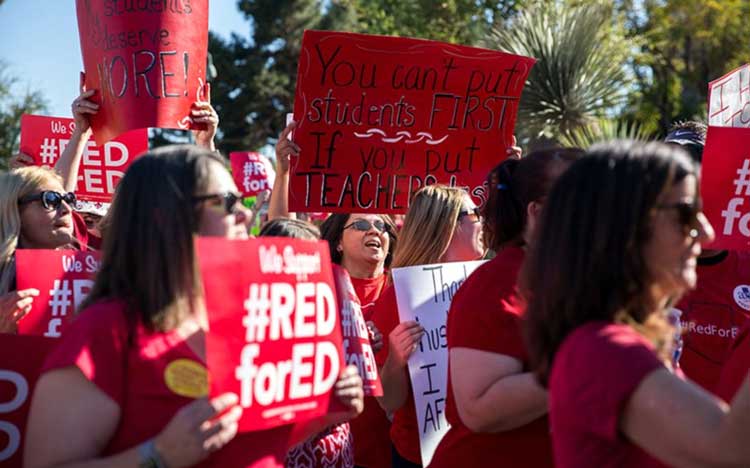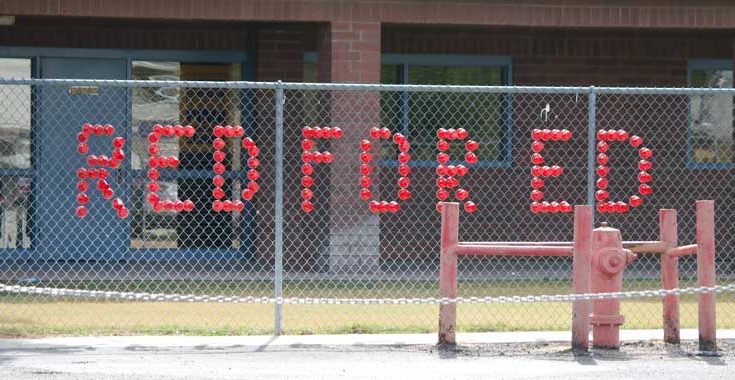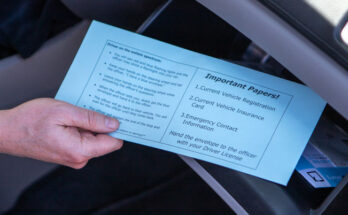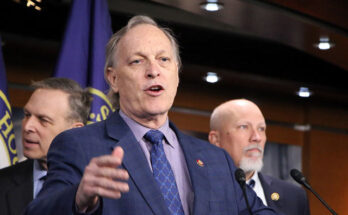Jon Johnson Photo/Gila Herald: A #RedForEd sign adorns Pima Elementary School. Arizona teachers have voted to go on strike starting Thursday, April 26.
By Jon Johnson
PHOENIX – The teachers have spoken and the overwhelming majority have chosen to strike. Now, parents, administrators and support staff will have to wait and see if rural teachers in Graham County do indeed walkout as schools prepare to attempt to deal with that possibility.
After a walk-in campaign to bring awareness to their cause, Arizona teachers will officially walkout on their jobs Thursday, April 26, according to a report by the Arizona Daily Star.
The Tucson newspaper reported that #RedForEd organizers said more than 57,000 teachers and school employees voted on whether to strike and that 78 percent answered in the affirmative.
The walk-ins will continue Monday through Wednesday, with teachers then walking out Thursday.
In Graham County, that will give parents and administrators the week and then the weekend to prepare as most of the area’s schools attend four days a week.

Pima Superintendent Sean Rickert said his district would do their best to keep the schools open by reaching out to substitute teachers, paraprofessionals and possibly restructuring the school day.
“If you don’t have teachers in schools, you’re going to have a hard time having learning in schools the way we are accustomed to it, Rickert said. “But, there are other things that we can do to make sure we meet the needs of our students and our parents to have a safe place for children to go where they are supported. You keep the cafeteria open; you run the buses; you provide opportunities for recess and we’ve got ample technology that we can utilize for student access for learning online.”
Safford Superintendent Ken VanWinkle told the Gila Herald that the “SUSD Leadership TEAM will be meeting to discuss options and possible plans should an actual walkout in Safford schools occur.”
VanWinkle said Safford’s biggest concern was to avoid a disruption of the school so the continued educations of its students can proceed.
“We appreciate the support we feel from our community and do not want to do anything as a school district to lose the trust and confidence from them,” VanWinkle wrote in an email to the Gila Herald. “While we support the need for additional funding for teachers and staff, as well as for supplies, curriculum, and materials, we hope to see our state legislators and the #RedforEd movement arrive at decisions that will prevent the potential disruption of the education process.”
That was the same sentiment in Thatcher, where Superintendent Dr. Kevin Spiller said while he supports the teachers 100 percent, as superintendent, he has to see what he can do, first and foremost, for the students in his district. Spiller said it is unknown how many Thatcher teachers might join the walkout and that on Monday morning the school’s normal leadership meeting will be geared toward discussing contingency plans to cover the potential loss of teachers. Spiller said his teachers have been wearing red but that the teachers haven’t had a big push for the walkout.
“We’re going to be prepared,” Spiller said. “Best case scenario, we’re going to try to keep the schools open . . . We’ve got meals to feed them (and) things like that. So, our first priority will try to maintain school in some form or fashion. If it gets to be where that’s not possible – if it’s just too much and we don’t have enough support staff – then we’ll just have to have a school stoppage.”
If that occurs, that could affect graduation dates and could extend the school year into summer if a solution is eventually resolved as students must have a certain mandated amount of days in school to move forward.
“We’re going to do our best to find win-win solutions, but that isn’t always possible,” Spiller said.
Rickert said he realizes the learning environment wouldn’t be the same but that he believes the vote to strike wasn’t as well supported in rural areas as it was in more metro areas. With roughly 57,000 teachers and school workers voting, Rickert said about 44,000 actually voted to strike. However, with 140,000 teachers throughout the state and with other school workers swelling that number to roughly 300,000 employees, Rickert said the people who actually voted is smaller than what news organizations may lead people to believe. He added that there is still time for teachers and Arizona Governor Doug Ducey to iron out a proposal that will leave both sides happy.
Recently, the Arizona PTA withdrew its support for Ducey’s proposed teacher pay increase plan that would have eventually increased wages by 20 percent. Teachers ultimately rejected the plan as well because it didn’t include other demands to increase funding in the classroom.
In addition to the 20 percent increase, teachers have also demanded:
- Restoration of per-pupil funding to 2008 levels. According to the Joint Legislative Budget Committee, Arizona spends $924 less per student than it did in 2008 after adjustment for inflation.
- No new tax cuts until said per-pupil funding reaches the national average. A National Education Association report showed Arizona spent $8,080 per pupil in 2016 compared to the national average of $12,682.
- A permanent pay structure where teachers would have guaranteed annual raises.
- Competitive pay for all employees in education.
According to a recent study, the Pima School District in the third-lowest paid district in the state.
Pima’s Choir and Music instructor Mike Bradley told the Gila Herald that he had been speaking with teachers in the district and that it appeared to be a “mixed bag” of whether they will indeed strike Thursday. He said while there was at least one teacher who took each side, all of them expressed their desire to do what was best for their students. Bradley said, for himself, he wants to “let things percolate” and get more feedback from other teachers before he makes his decision.

“I know the sentiment among our teachers in Pima was that whatever anybody’s choice is – whether it is to walkout or not – that we’re in it together and we’re going to support people’s decision,” Bradley said. “As we talked about it every teacher seems to have the kids’ best interest at heart. Some want to stay in the school and be there for the kids and the ones that want to leave were talking about what that was going to do funding wise long term for the kids.”
Bradley said he had wanted to take a wait-and-see position as to Ducey’s plan, but after reviewing the line items and seeing where the funding would come from by taking away funding for programs for students with developmental disabilities and arts programs and how it would hurt other areas of the state he had a change of heart. He added that Ducey’s proposal doesn’t appear to be sustainable. Bradley said he also has concerns about how a long-term strike could affect public sentiment against the teachers and that Ducey has a war chest of $3 million for propaganda posting.
“I’m still torn on whether the strike should happen or not, but that choice is kind of out of my hands now,” Bradley said. “I think there is value in solidarity at this point . . . It’s hard when your heart is in your job and your heart is with the kids. Short term, staying with the kids is best. Long term, maybe the walkout is the best, so we’ll just have to play it by ear.”







